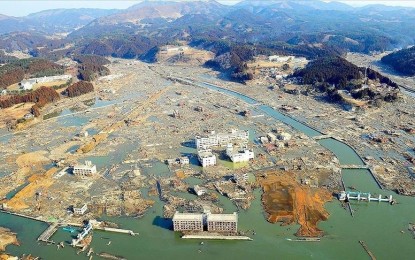
(Photo from Anadolu)
LONDON – Besides causing tens of thousands of deaths and unprecedented sorrow, the world’s major earthquakes in the last 50 years also created nearly USD1 trillion in economic damage, according to data compiled by Anadolu.
The March 11, 2011 magnitude 9.1 earthquake and tsunami in Tohoku, Japan claimed the lives of nearly 20,000 people and caused 70 million cubic meters of rubble, data from the United Nations Development Program (UNDP) shows.
The Tohoku earthquake also created the largest property loss at USD360 billion, while it is also the most expensive in world history in terms of insured losses at USD47 billion, according to the Insurance Information Institute (I.I.I.).
The Great Hanshin earthquake, a 6.9 magnitude earthquake in Japan in 1995, led to a death toll of over 6,400 with USD200 billion in economic damage.
The magnitude 8 Sichuan earthquake in 2008 in southern China, which caused the deaths of more than 87,000 people, resulted in an estimated damage of USD150 billion.
The US experienced one of its most costly earthquakes, Northridge, on Jan. 17, 1994, when a magnitude 6.7 earthquake shook Los Angeles, California. The economic damage was calculated as USD50 billion.
It was the second-largest earthquake in world history in terms of insured losses at USD31 billion, according to I.I.I.
New Zealand's 6.3 magnitude Christchurch earthquake in 2011, leading to the deaths of 185 people, resulted in property losses of USD40 billion with USD14 billion of the damage covered by insurance.
Chile’s 8.8 magnitude earthquake on Feb. 27, 2010, one of the strongest earthquakes, was followed by a tsunami.
The quake claimed the lives of more than 500 people and caused USD30 billion worth of damage. According to Guy Carpenter & Company, LLC, a leading global risk and reinsurance specialist, USD8.2 billion of this damage was covered by insurance, and the earthquake claimed a spot among the costliest for the insurance sector.
The 2004 Chuetsu earthquake in Japan's Niigata prefecture, with a magnitude of 6.6, killed 40 people and injured around 3,000 as it caused an economic loss of USD28 billion.
Sumatra quake killed 230,000, caused USD10 billion loss
In one of the world’s largest earthquakes in the world, Sumatra, Indonesia was shaken by a 9.1 magnitude temblor on Dec. 26, 2004.
Around 230,000 people were killed and 1.7 million were displaced by the quake and the tsunami in 14 countries in South Asia and East Africa, according to the US Geological Survey.
The earthquake created USD10 billion in economic damage and 12 million cubic meters of rubble.
A magnitude 7.0 earthquake that hit Haiti in 2010 claimed the lives of more than 200,000 people, while its total property loss was USD8.5 billion and it led to 10 million cubic meters of rubble.
A magnitude 7.8 earthquake in Nepal in 2015 killed around 8,964 people, injured 21,952, and caused about USD10 billion in economic damage. The country had to contend with 27 million cubic meters of rubble and is still engaged in recovery efforts.
Quakes in Türkiye
Türkiye saw the most powerful and twin earthquakes on Feb. 6, 2023, that killed 45,968 people, including 4,267 Syrians.
The magnitude 7.7 and 7.6 quakes struck 11 Turkish provinces -- Adana, Adiyaman, Diyarbakir, Elazig, Hatay, Gaziantep, Kahramanmaras, Kilis, Malatya, Osmaniye, and Sanliurfa.
More than 13 million people in Türkiye have been affected by the quakes, which also hit Syria.
The twin quakes produced 100 million cubic meters of rubble, according to the UNDP.
A magnitude 7.5 earthquake that hit Türkiye on Aug. 17, 1999, killed 17,480 people and led to economic damage of USD17.1 billion, according to the Turkish Enterprise and Business Confederation. (Anadolu)
